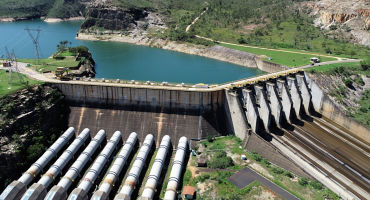- Investment Director
Skip to main content
- Funds
- Insights
- Capabilities
- About Us
- My Account
The views expressed are those of the authors at the time of writing. Other teams may hold different views and make different investment decisions. The value of your investment may become worth more or less than at the time of original investment. While any third-party data used is considered reliable, its accuracy is not guaranteed. For professional, institutional, or accredited investors only.
Every year, World Water Day is held on March 22 to highlight the need to solve the world’s water and sanitation crises — 2.2 billion people currently live without access to safe water, while 4.2 billion go without safe sanitation services.1 The significance of this finite resource is wide-reaching, with the United Nations (UN) estimating that water is the primary medium through which we will feel the effects of climate change.2
The UN has estimated that around 70% of the earth is covered by water. Only 2.5% of that is fresh water — essential for drinking, growing and production — while less than half of that is usable and easily accessible. The rest is salt water, polluted or locked up in polar ice caps, glaciers and permafrost.
The effects of climate change are increasingly exacerbating this scarce supply:
Wellington’s research with Woodwell Climate Research Center has reaffirmed the investment case for solutions that strengthen water infrastructure and advance water conservation and efficiency. Some are long term — for instance, desalination is an expensive process with potentially negative environmental side effects but, with intensifying water scarcity, it may become a more viable option in certain regions. More immediate opportunities relate to the fragmented water value chain, where we think businesses may be able to consolidate competitive advantages and drive change, particularly by leveraging digital capabilities.
Our impact investment teams have observed that companies and issuers are increasingly developing innovative solutions across the water value chain. Below are a few examples.
Evoqua6 offers a range of water and wastewater treatment solutions, which include disinfection, filtration and high-purity water systems. The company has contributed to more than 200,000 installations, the removal of 166,297 kg of metal during water treatment and the processing of 141.6 billion cubic metres of water.7
Aegea6 provides clean water and sewage services across Brazil, with its operations spanning more than 150 cities. The company’s services reach 21 million individuals across more than 3.7 million households.8 Aegea’s products and services aim to improve water security and reduce water loss, and include repairing and replacing water networks, drilling aquifers and installing water pressure meters.
Supreme Industries6 is an Indian manufacturing company with a wide range of plumbing and sanitation products. The company already has a large manufacturing footprint across India and has a strong addressable market opportunity, given that over 70% of sewage in India is discharged untreated — polluting rivers, coastal areas and wells across 75% of the country’s water bodies.9
As highlighted in Wellington’s 2021 Global Impact Annual Report, our impact investments within our clean water and sanitation theme supported infrastructure and technology solutions across the water cycle in 2021, translating into more than 147 billion cubic metres of water provided or treated.
Within our impact investment approaches at Wellington, we evaluate companies and issuers based on materiality, additionality and measurability. First, impact activity must be central to the company or issuer, with the majority of their core products or services aligned with one or more of our 11 impact themes.10 Second, the company or issuer must address an unmet need or an underserved population in a unique or differentiated way. Lastly, we must be able to measure the impact by identifying a key performance indicator (KPI) that we can use to track the progress of our investments.
Our impact measurement and management framework is centred around five key factors. For each impact investment, we:
Active engagement with our impact investments allows our investment teams to deepen their insights into how companies’ and issuers’ products and services contribute to our impact themes; in turn, this sharpens our discussions with management teams about how companies measure positive and negative environmental and social outcomes. Engagement also enables us to clarify our impact rationale, discuss impact trends and suggest additional disclosures or new metrics where needed.
In recent years, notable progress has taken place in the innovative solutions being developed and deployed by water treatment and management companies around the world.
However, with the UN estimating a staggering funding gap of US$114 billion per year to achieve UN Sustainable Development Goal 6 (Clean Water & Sanitation) by 2030,11 there remains a long way to go.
Ultimately, we believe that investors, businesses and governments each have a crucial role to play to help plug this finance gap, as part of the efforts globally to transition towards a sustainable future.
1Progress on drinking water, sanitation and hygiene: 2000 – 2017: Special focus on inequalities, United Nations Children’s Fund, World Health Organization, June 2019 (note: this is the latest available projected figure). | 2Climate Change and Water: UN-Water Policy Brief, September 2019 (note: this is the latest available projected figure). | 3World Resources Institute, March 2021 (note: this is the latest available projected figure). | 4United Nations Framework Convention on Climate Change and Ramsar Convention on Wetlands. | 5OECD Environmental Outlook to 2050: The Consequences of Inaction, November 2011 (note: this is the latest available projected figure). | 6The examples shown are based on non-performance criteria and are for illustrative purposes only. They are not to be viewed as representative of actual holdings. It should not be assumed that any client is invested in the (or similar) examples, nor that an investment in the examples has been or will be profitable. Actual holdings will vary for each client, and there is no guarantee that a particular client’s account will hold the examples presented. Please refer to the Important disclosures section for information on investment examples. Data is that of a third party. While data is believed to be reliable, no assurance is being provided as to its accuracy or completeness | 7Evoqua Water Technologies, 2021 Sustainability Report, as of 31 December 2021 (note: this is the latest available projected figure). | 8Aegea Earnings Release, 3Q22. | 9Government of India, Ministry of Commerce and Industry, as of 7 March 2023. | 10Wellington’s impact investment process is underpinned by a proprietary thematic framework, comprising 11 themes that address some of the world’s largest environmental and social challenges. Wellington Management supports the United Nations Sustainable Development Goals. | 11United Nations, Synthesis Report on Water and Sanitation, 2018 (note: this is the latest available projected figure).
Experts


Impact measurement and management: addressing key challenges
Continue readingDecoding impact expectations: best practices for impact investors and companies
Continue readingImpact investing in emerging markets: Growing opportunities, shifting challenges
Continue readingWhy an impact lens is an important tool in the fixed income investor's arsenal
Continue readingURL References
Related Insights
Stay up to date with the latest market insights and our point of view.
Related Insights

Measuring impact in venture capital
We highlight why venture capital matters to impact investors and how to authentically measure and manage impact in this asset class.

Impact measurement and management: addressing key challenges
Our IMM practice leader describes common impact investing challenges and suggests ways to overcome them.

Decoding impact expectations: best practices for impact investors and companies
We share three recommendations each for impact investors and companies to help them better understand and manage each other's expectations.

Impact measurement and management practices
What constitutes an impact investment? How is impact measured? And, what are the benefits of impact investing? Our Impact Management and Measurement Practice Leader Oyin Oduya discusses our approach.

Assessing the impact of climate resilience
Oyin Oduya and Louisa Boltz discuss the case for impact solutions focused on climate adaptation and share high-level guidelines to help overcome the associated measurement challenge.

Impact investing in emerging markets: Growing opportunities, shifting challenges
Members of our impact bond team discuss their evolving emerging markets opportunity set and the importance of a bottom-up approach to value creation.

Why an impact lens is an important tool in the fixed income investor's arsenal
Campe Goodman, Will Prentis and Oyin Oduya discuss how an impact lens can be an important tool in the fixed income investor's arsenal.
Green horizons: How the shift toward sustainable finance may reshape fixed income markets
Three sustainability trends have the potential to reshape fixed income markets, leading to a range of new opportunities for investors.
More green shoots: Tracking trends in sustainable debt issuance
While growth in the sustainable debt market has been uneven, certain pockets offer substantial opportunities. Two of our fixed income investment professionals weigh in.
Activism – History and evolution in Japan
Investment Specialist Toshiki Izumi examines the history of shareholder activism in Japan, with particular emphasis on the differences between current and historical attitudes toward activism.

Blue bonds: long-awaited innovation or yet to make a splash?
Blue bonds – which aim to support projects related to ocean conservation – are on the rise. How effective are they and what do investors need to know before they invest?
URL References
Related Insights